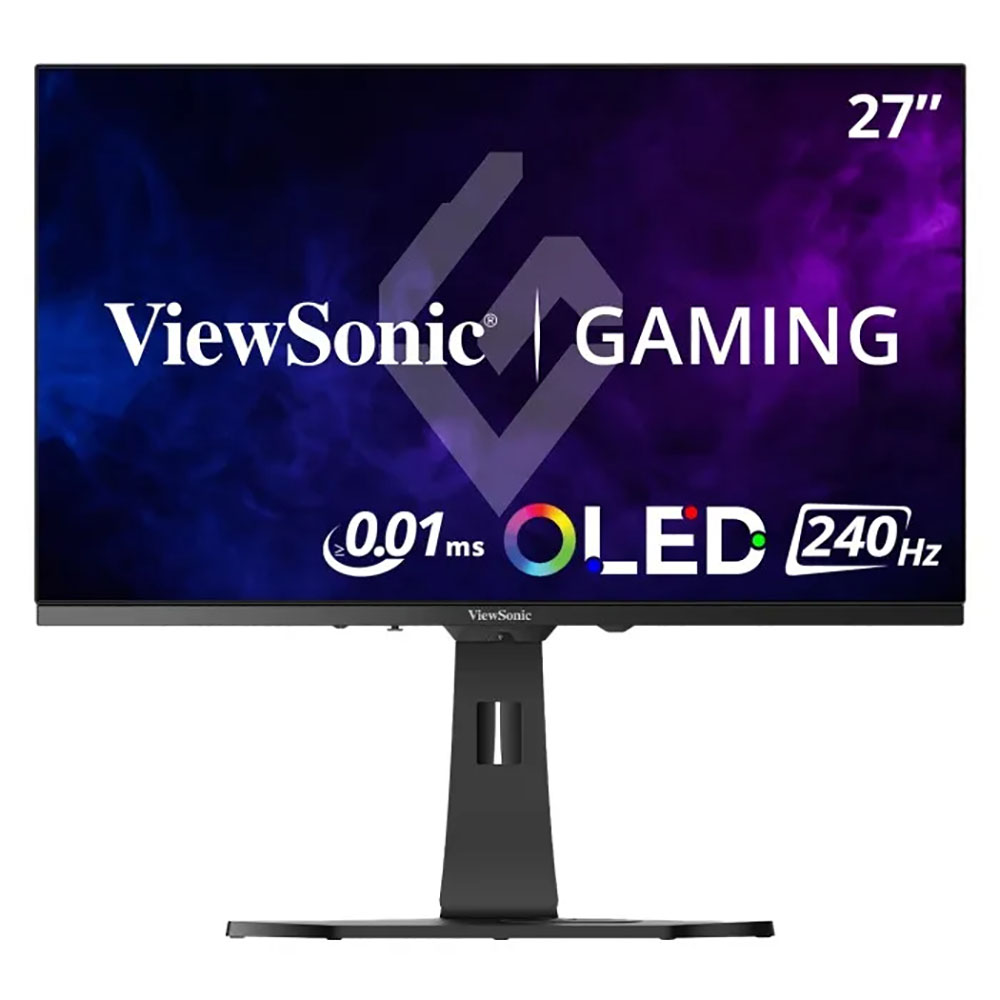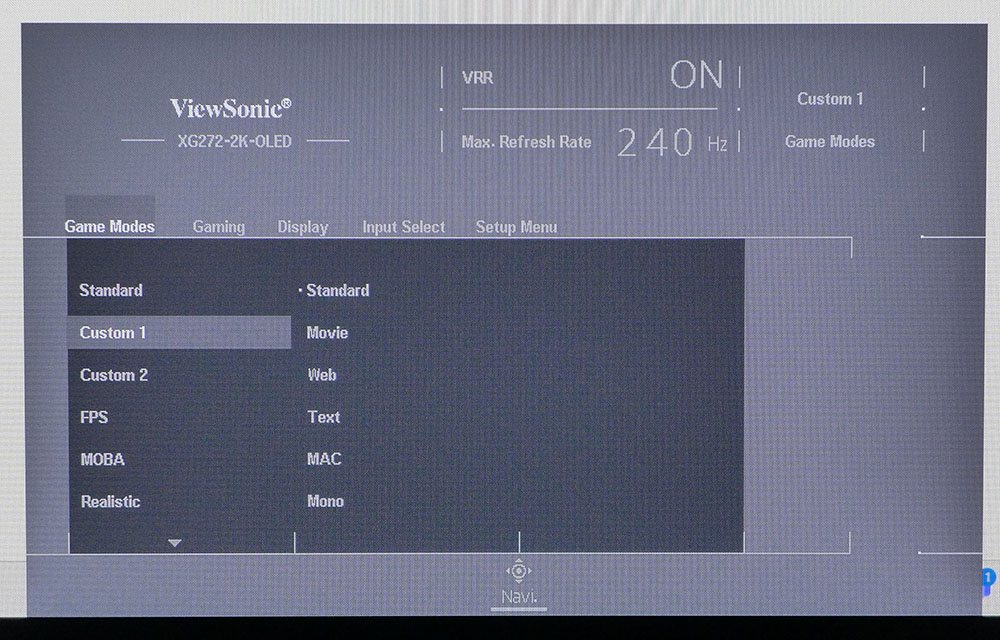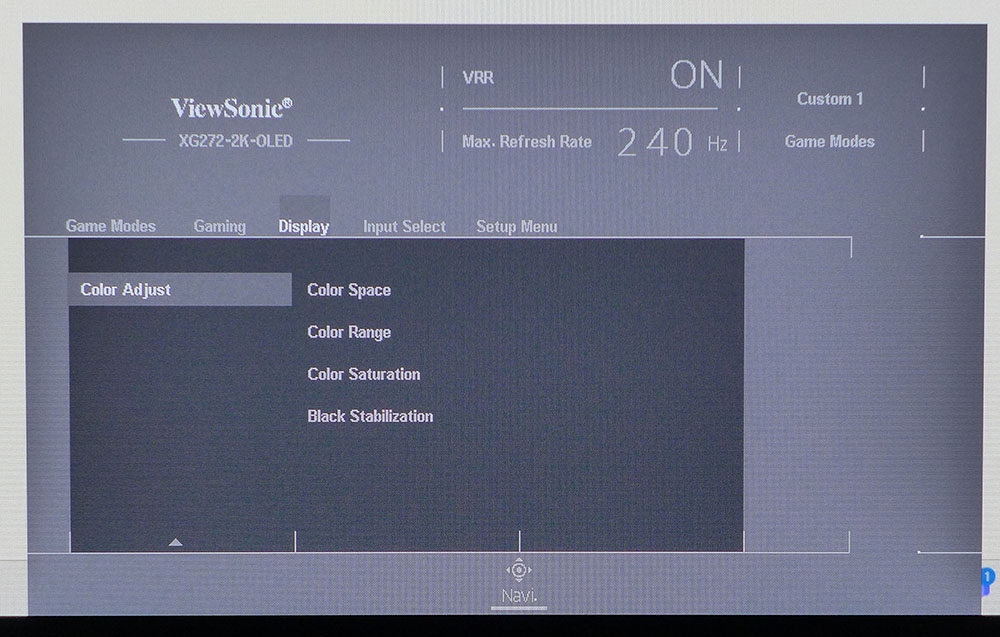Tom's Hardware Verdict
The ViewSonic XG272-2K-OLED has a few minor flaws but delivers the brightest HDR in its price class. With immersive and precise video processing, it has the same addictive gameplay as any other premium OLED monitor.
Pros
- +
Brightest in class HDR with deep blacks and broad contrast
- +
Near 100% coverage of DCI-P3 color
- +
Can be enjoyed without calibration
- +
Superb video processing with perfect motion resolution
- +
Black frame insertion option for blur reduction at low frame rates
- +
Attractive styling with handheld remote
Cons
- -
Light gamma for SDR content
- -
Slight blue tint for HDR content
- -
No sRGB mode
Why you can trust Tom's Hardware
OLED computer monitors are becoming a plentiful commodity among the best gaming monitors. They’re not yet inexpensive, but their price will eventually come down as more models vie for attention among gaming enthusiasts.
From a numbers perspective, the hot sub-category is 27-inch 240 Hz QHD panels. They offer fantastic performance with zero motion blur and low input lag. It doesn’t hurt that they also cover 100% or more of the DCI-P3 color gamut and deliver the best HDR possible, thanks to true blacks and infinite contrast.
ViewSonic has entered the fray with its XG272-2K-OLED. It’s an attractive 27-inch QHD OLED display with 240 Hz, G-Sync and FreeSync certification, black frame insertion capability, very bright HDR, and wide gamut color. Let’s take a look.
ViewSonic XG272-2K-OLED Specs
| Panel Type / Backlight | Organic Light Emitting Diode (OLED) |
| Screen Size / Aspect Ratio | 27 inches / 16:9 |
| Max Resolution and Refresh Rate | 2560x1440 @ 240 Hz |
| Row 3 - Cell 0 | FreeSync and G-Sync Certified |
| Native Color Depth and Gamut | 10-bit / DCI-P3 |
| Response Time (GTG) | 0.02ms |
| Brightness (mfr) | 450 nits |
| Contrast | Unmeasurable |
| Speakers | 2x 3w |
| Video Inputs | 2x DisplayPort 1.4 |
| Row 10 - Cell 0 | 2x HDMI 2.1 |
| Row 11 - Cell 0 | 1x USB-C |
| Audio | 3.5mm headphone output |
| USB 3.0 | 1x up, 3x down or None |
| Power Consumption | 35.5w, brightness @ 200 nits |
| Panel Dimensions WxHxD w/base | 23.8 x 17.6-22.3 x 8.5 inches (605 x 447-566 x 216mm) |
| Panel Thickness | 2.5 inches (64mm) |
| Bezel Width | Top/sides: 0.4 inch (10mm) |
| Row 18 - Cell 0 | Bottom: 1 inch (25mm) |
| Weight | 15.3 pounds (7kg) |
| Warranty | 3 years |
I’ve looked at quite a few OLEDs lately, and in terms of color, they fall into two groups: Quantum Dots and Not Quantum Dots. The XG272-2K is one of the latter. It covers a hair less than 100% of DCI-P3, which is still more colorful than nearly all LED and Mini LED panels currently available. Quantum Dots will get you closer to 114%, but 100% is still a lot.
Both flavors of Adaptive-Sync bolster gaming performance. The XG272-2K is certified by Nvidia and AMD, and it has worked flawlessly in all my motion processing and gaming tests. At 240 Hz, there is no motion blur whatsoever. And if you can keep the fun over 200fps, it will always look perfectly smooth. Also supported is black frame insertion (BFI), which operates instead of Adaptive-Sync. It has the same effect as backlight strobing in an LCD panel. Here, you can vary the minimum refresh rate and increase the length of each black frame. Longer times mean less blur but also less light output. This feature is unnecessary at high frame rates, but it is useful if your system can’t push the XG272-2K past 150fps.
Styling is unique in that the XG272-2K has a white back panel and stand. It looks right at home with the latest consoles or fancy gaming PCs. Also included is a handy remote, which fits into a special cutout in the base. There aren’t many 27-inch monitors with remote controls, so this is a nice value-add.
Extras include LED lighting, which emanates from a cool cutout shape on the back. You can set up static or breathing effects in the OSD. A tiny joystick protruding from the bottom bezel controls the fun and a pair of internal speakers deliver polite audio. There are plenty of inputs with two each of the latest HDMI 2.1 and DisplayPort 1.4 plus USB-C. And you get one upstream and three downstream USB ports for peripherals.
Get Tom's Hardware's best news and in-depth reviews, straight to your inbox.
The XG272-2K is a full featured solid performing OLED monitor that sells at this writing for around $900. That’s right in the thick of the category, as it is neither higher nor lower priced than similarly spec’d competition from other mainstream brands.
Assembly and Accessories
The XG272-2K comes in a slim carton with plenty of crumbly foam to protect the premium contents. The base, upright and panel assemble with no need for tools. A 100mm VESA lug pattern is provided, but you’ll need to source your own fasteners if you plan to use a mounting arm. The cable bundle is just one DisplayPort and one USB-A/B. The panel is kept slim thanks to a large external power brick fed by an IEC cord.
Product 360





The XG272-2K’s white bits are kept out of sight from the front. The bezel is flush and thin with black trim across the bottom. And the stand’s forward side is black as is the solid metal base. From the sides and back though, it’s all white all the time. It’s a refreshing change from the all-black monitors I’m so used to seeing. There are no straight lines or sharp corners either. Everything is a gentle curve or taper, very nice.
The base has a cutout for the remote control, which is certainly unusual for a 27-inch monitor. When I first put it in, I wondered how one would easily remove it, but I discovered that pressing its lower right corner pops it right out. Some clever designer engineered a notch into its backside, so it flips up when pressed.
The stand has full ergonomics with 4.7 inches of height, 5/20 degrees tilt and 20 degrees swivel. You also get a 90-degree portrait mode and there, I found a bit too much play. The rotation takes very little effort which means it’s hard to keep the panel perfectly level. Once I got it positioned, I had to take care not to bump it, or it would sit crooked. This stand is not quite up to ViewSonic’s usual standard.
The input panel is up and under the center and includes two each of DisplayPort 1.4 and HDMI 2.1 plus USB-C for video. One upstream and three downstream USBs support peripherals and you get a 3.5mm headphone jack. The internal three-watt speakers play at polite volumes without distortion or much in the way of bass.
OSD Features
The XG272-2K’s OSD is text-based but still manages to look stylish with its gray background and thin lines around lists and fields. It has mode and VRR status at the top and groups the settings into five sub-menus.






There are eight total picture modes. The two Custom presets have further presets for specific tasks. To avoid confusion, I recommend sticking with Custom 1 and Standard. You can calibrate the color temp for good grayscale tracking but there are no gamma presets or color gamut selections. HDR signals activate three additional modes of which DisplayHDR is the default and best choice.
The game menu, in addition to the HDR modes, also has black frame insertion (BFI), which is something not seen on too many OLED monitors. It works instead of Adaptive-Sync, like the backlight strobe technology in LCDs. It reduces motion blur at the expense of light output. If you can run faster than 150fps, VRR is the better choice. The aiming point options include three different symbols which can be rendered in green, white or yellow. This menu also has the lighting effects, which can be static or breathing in red, green or blue. Or you can turn the lights off if you wish.
In the Display menu you get six color temps, one of which has RGB sliders. The sRGB option suggests that smaller color gamut but, in my tests, color did not change when I selected it. The XG272-2K has no sRGB mode. You can also select color format, video range and color saturation level along with a black stabilization feature that brightens hard to see shadow areas.
ViewSonic XG272-2K-OLED Calibration Settings
The XG272-2K can be used in its default Custom 1/Standard picture mode without calibration, but there’s an issue. Gamma is quite light in tone, tracking closer to 2.0 rather than the standard 2.2. This washes out the image a bit and even though it still has deep blacks and broad contrast, it doesn’t possess the glow most OLEDs have. If you choose the user color temp (Full Color Control), grayscale tracking can be improved to a higher degree of accuracy, but without gamma presets, there is no way to get any closer to perfection. There is also no sRGB color option. You’ll see the full native gamut, nearly 100% of DCI-P3, for all SDR and HDR content. Below are my recommended SDR settings. In HDR mode, stick with DisplayHDR for the best possible image.
| Picture Mode | Custom 1, Standard |
| Brightness 200 nits | 100 |
| Brightness 120 nits | 62 |
| Brightness 100 nits | 52 |
| Brightness 80 nits | 41 |
| Brightness 50 nits | 27 (min. 5 nits) |
| Contrast | 70 |
| Full Color Control | Red 99, Green 96, Blue 83 |
Gaming and Hands-on
Despite some color and gamma anomalies you’ll read about later, the XG272-2K’s gaming experience is on par with other 240 Hz QHD OLED monitors. Speed is delivered efficiently with no problems encountered at 240fps. Keeping the frame rate maxed means there is no need for the black frame insertion feature. But using it has no downside. It works perfectly without visible artifacts, and it is very effective at removing blur when the fps count is below 150. You can easily pair the XG272-2K with lower-priced video cards and enjoy high-motion resolution.
Playing Doom Eternal in HDR mode showed the XG272-2K’s tremendous contrast. Black levels were deep and true even though I noted some light luminance values in testing. The overall image was slightly blue, which made it a little less vibrant than other OLEDs I’ve reviewed. But unless you compare them side by side as I did, the errors don’t constitute a deal-breaker.
Input lag was imperceptible, so my aim and movement had the precision to which I’ve become accustomed when playing on OLED monitors. This display technology is perfectly suited for full motion first person gaming whether it’s a shooter or driving sim. The deep contrast makes careful exploration of virtual environments much more realistic and immersive.
I had no issues to report when using the XG272-2K for daily tasks. OLED is perfect for document editing because black text really pops against the white backgrounds of Windows or MacOS. Color saturation is very high, which makes videos and websites more engaging. If you’ve read my comments in other OLED display reviews, you will notice by now that I’m spoiled by this technology.
Takeaway: The XG272-2K has the same look and feel as every other premium OLED display that I’ve reviewed. Gaming feel is precise and smooth. It has fantastic color saturation. And broad contrast takes the image to another level over the very best Mini LED screens. Though I noted some color issues in HDR mode, they weren’t enough to keep me from enjoying hours of play.
MORE: Best Gaming Monitors
MORE: How We Test PC Monitors
MORE: How to Buy a PC Monitor
Current page: Features and Specifications
Next Page Response, Input Lag, Viewing Angles and Uniformity
Christian Eberle is a Contributing Editor for Tom's Hardware US. He's a veteran reviewer of A/V equipment, specializing in monitors. Christian began his obsession with tech when he built his first PC in 1991, a 286 running DOS 3.0 at a blazing 12MHz. In 2006, he undertook training from the Imaging Science Foundation in video calibration and testing and thus started a passion for precise imaging that persists to this day. He is also a professional musician with a degree from the New England Conservatory as a classical bassoonist which he used to good effect as a performer with the West Point Army Band from 1987 to 2013. He enjoys watching movies and listening to high-end audio in his custom-built home theater and can be seen riding trails near his home on a race-ready ICE VTX recumbent trike. Christian enjoys the endless summer in Florida where he lives with his wife and Chihuahua and plays with orchestras around the state.
